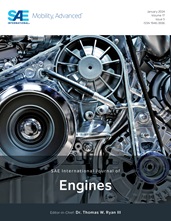Experimental Analysis of Soot and NOx Mitigation during Energy-Buffered Diesel Engine Transients
- Features
- Content
- Transient operation of a diesel-fueled compression ignition engine will produce significant levels of engine-out criteria pollutants such as NOx and soot emissions due to turbocharger lag. Conventional pollutant mitigation strategies during tip-ins (large increases in load) are constrained by the soot–NOx trade-off—strategies that mitigate soot/NOx emissions often result in an increase in NOx/soot emissions. Hybridization offers the ability to use an e-machine as an energy buffer during a tip-in, allowing the engine to tip-in slower to give the turbocharger time to spin up and provide the necessary amount of air for clean, high-load operation. In this work, an in-line six-cylinder 12.8 L Detroit Diesel DD13 engine was used to study the impact of slowing the torque ramp rate of a tip-in on the effectiveness of transient emission reduction strategies for turbocharged diesel engines, including exhaust gas recirculation (EGR) valve closing, start of injection retard, and the air–fuel ratio threshold with which these emissions reduction techniques are activated. The experiments showed that smoke emissions can be reduced without a corresponding increase in NOx emissions by slowing the tip-in. It was also found that the NOx penalty of reducing EGR flow was attenuated with a slowed tip-in, enabling more aggressive smoke mitigation strategies. Overall, it was shown that a combination of slowing a B25-B75 (from the 13-mode supplemental emissions test) tip-in and reducing EGR flow during the tip-in, the smoke emissions during the tip-in could be reduced by approximately 50% while reducing NOx emission by approximately 4%.
- Pages
- 14
- Citation
- Gainey, B., Datar, A., Bhatt, A., and Lawler, B., "Experimental Analysis of Soot and NOx Mitigation during Energy-Buffered Diesel Engine Transients," SAE Int. J. Engines 18(2):249-262, 2025, https://doi.org/10.4271/03-18-02-0014.
